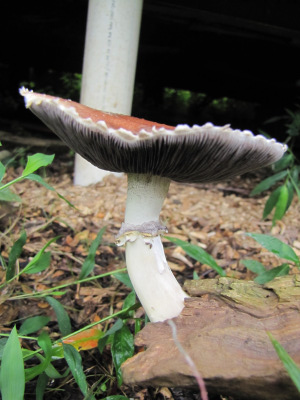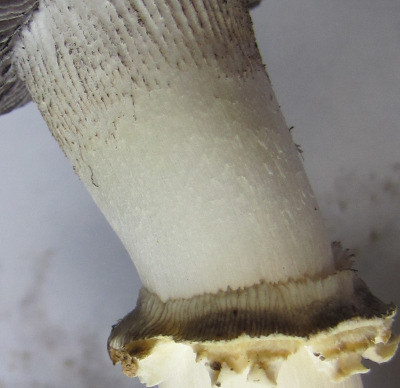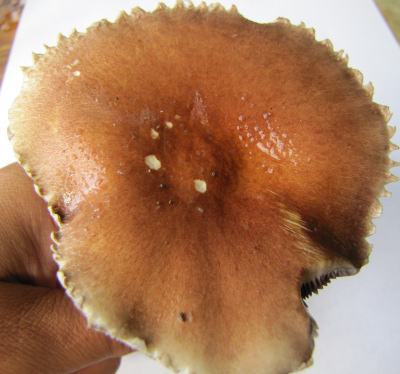
King Stropharia identification
 I'm a bit shocked by my own
mycophobia --- I almost threw away the first King
Stropharia mushroom
that popped up from our graywater
mycoremediation project. This is our first
year growing Stropharia
rugosoannulata, but that's really
no excuse. I was the one who researched and chose the species and
personally inoculated the wood chips. But the mushroom that
sprang up didn't look all that much like the pictures I'd quickly
browsed on the internet, and I thought a wild fungus had invaded my
mycoremediation project.
I'm a bit shocked by my own
mycophobia --- I almost threw away the first King
Stropharia mushroom
that popped up from our graywater
mycoremediation project. This is our first
year growing Stropharia
rugosoannulata, but that's really
no excuse. I was the one who researched and chose the species and
personally inoculated the wood chips. But the mushroom that
sprang up didn't look all that much like the pictures I'd quickly
browsed on the internet, and I thought a wild fungus had invaded my
mycoremediation project.
After a more lengthy
perusal of the internet (and my field guide to mushrooms), I decided
this lovely specimen was indeed a King Stropharia. We ate it
sauteed in garlic last night, so I assume I was right. Here are
the top tips I've run across for King Stropharia identification.
 First,
take a look at the ring around the mushroom's stem. Several other
mushrooms have rings, but the ring on a King Stropharia mushroom has
indentations from the gills along the top, giving it a lined
appearance. The lined ring is probably one of the most diagnostic
features of King Stropharia.
First,
take a look at the ring around the mushroom's stem. Several other
mushrooms have rings, but the ring on a King Stropharia mushroom has
indentations from the gills along the top, giving it a lined
appearance. The lined ring is probably one of the most diagnostic
features of King Stropharia.
Next, take a look at the
gills on the underside of the cap. Notice that they are attached
to the stem and are a purply-gray in color. If the gills are
free, then you might have an Agaricus, so beware! Some Agrocybe mushrooms can look similar
too, but have brown gills.

 The
top of the cap is often maroon in young specimens, but can also be
plain old brown (especially as the mushroom ages), so cap color isn't
so diagnostic.
The
top of the cap is often maroon in young specimens, but can also be
plain old brown (especially as the mushroom ages), so cap color isn't
so diagnostic.
I find it interesting
that our mycoremediation patch has fruited while the patches I
inoculated at the same time under the canopies of nearby fruit trees
have not. Clearly, the bit of bleach in the dishwater doesn't
hurt King Stropharia one bit, and frequent soakings are a boon.
Paul Stamets has written that King Stropharia mushrooms may actually
depend on coliform bacteria for growth --- perhaps the bacteria going
down the drain have helped our mycoremediation patch come out ahead?
Want more in-depth information? Browse through our books.
Or explore more posts by date or by subject.
About us: Anna Hess and Mark Hamilton spent over a decade living self-sufficiently in the mountains of Virginia before moving north to start over from scratch in the foothills of Ohio. They've experimented with permaculture, no-till gardening, trailersteading, home-based microbusinesses and much more, writing about their adventures in both blogs and books.
Want to be notified when new comments are posted on this page? Click on the RSS button after you add a comment to subscribe to the comment feed, or simply check the box beside "email replies to me" while writing your comment.

This is funny and it reminds me of when Seth and I grew our first baby lettuce. We KNEW what the lettuce was supposed to look like, and we KNEW that some of them were bitter, but every time we took a bite of it we were a little uneasy and we asked ourselves "Are we really eating lettuce and not some toxic weed that sprung up in the garden?" I even KNEW nearly all the weeds that could have grown up there, and logically I knew that this wasn't one of them.
It was really silly to me that I had that kind of phobia of eating my own garden veggies. This was the first garden we grew and I thought I'd be a lot more confident, but I just couldn't ditch the doubt.
Anyway, congrats one the mushroom growing and proper identification! We're hoping to start with mushrooms within the next year or so and if we plan to grow this species, this ID will definitely help us. Thanks.
I started a forest garden in my yrd last fall. Started with a 110' swale that accepts overflow water from rain barrels. Along side the swale is 110' of hugelkultur
I planted lots of perennials and lots of other seeds this spring
In summer my sister of 60 years decided to visit. She's a compulsive weeder
I had to be honest at one point and say "sis, I planted a lot of stuff and I have no idea what they look like so could we not pull weeds so quickly?"
The only things I knew for sure were the trees / shrubs and the 28 comfrey because they're big and input them there specifically